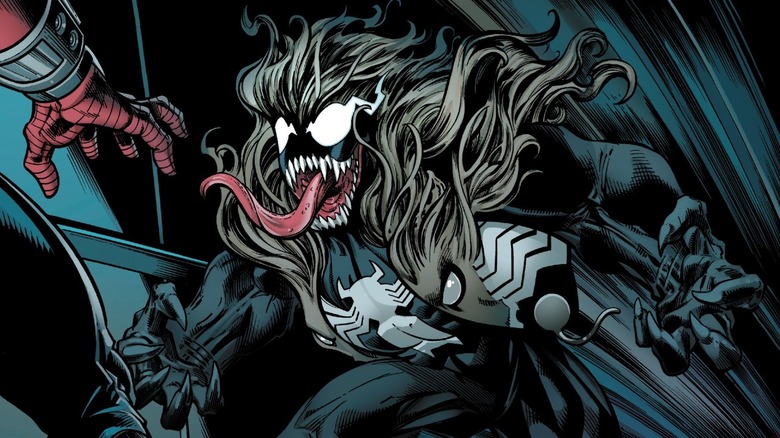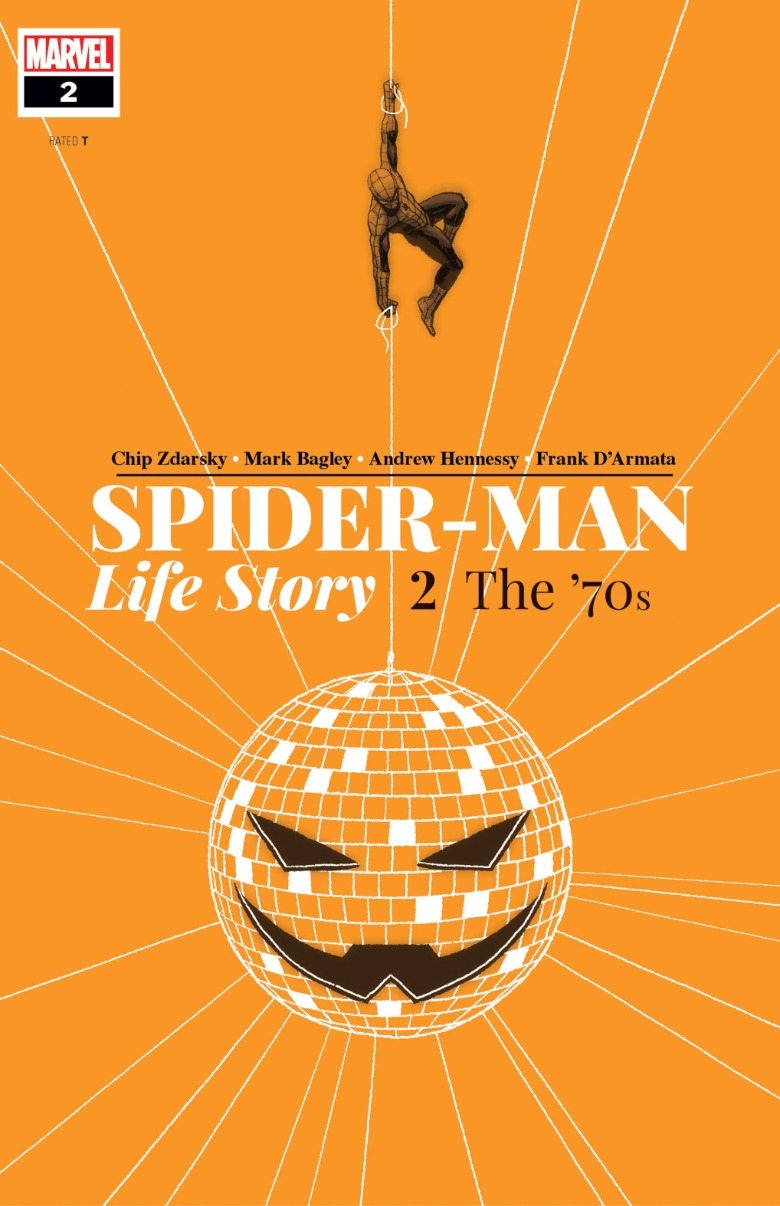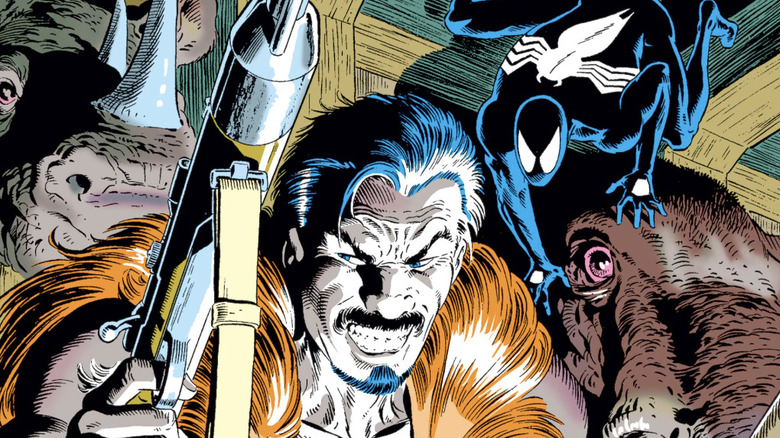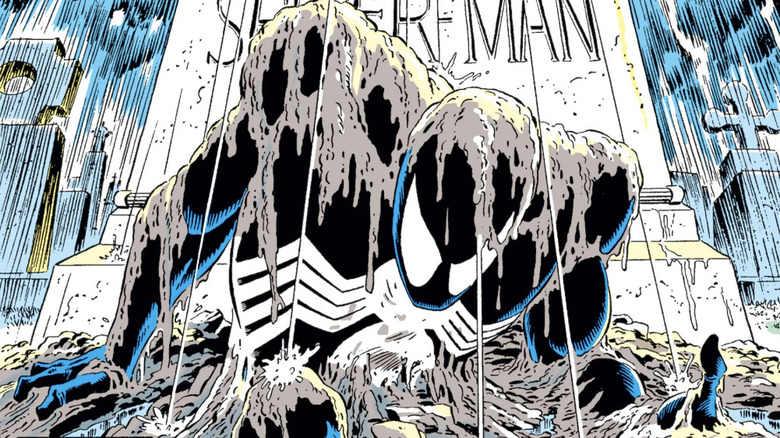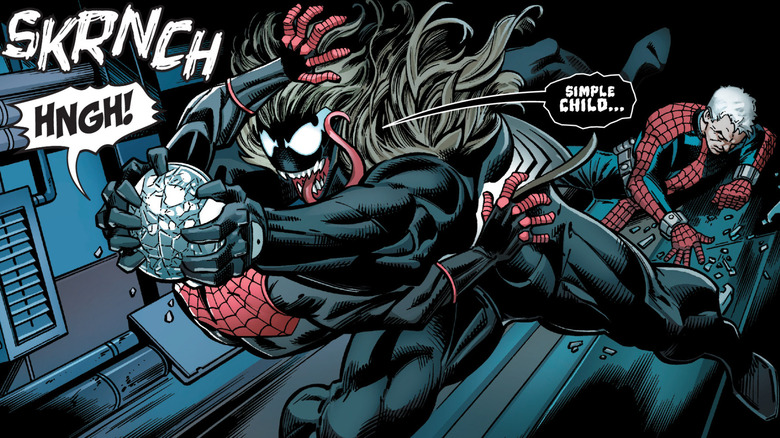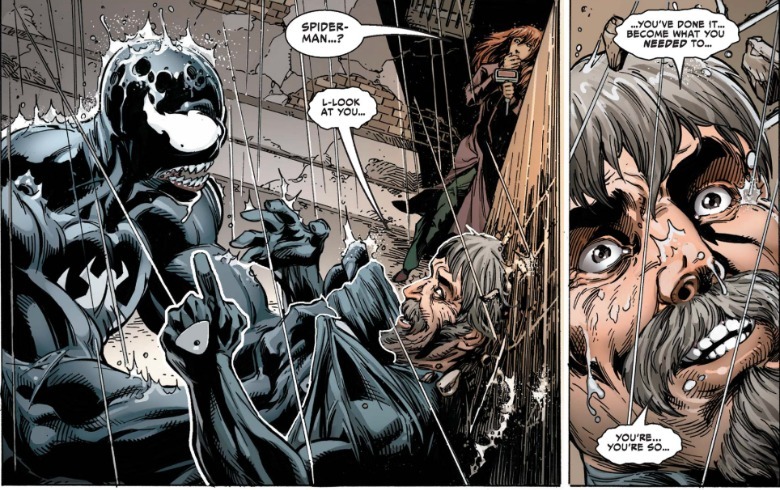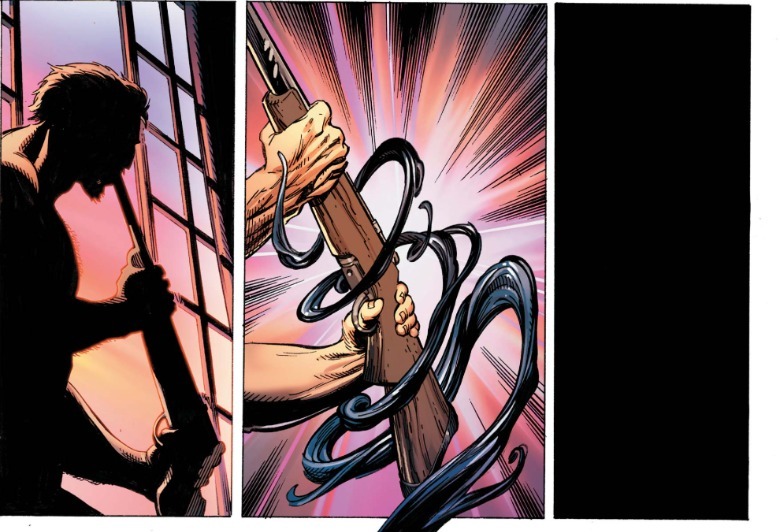The Marvel Comic That Combined Two Of Spider-Man's Greatest Enemies
Sony Pictures' woebegotten Spider-Man Universe (no Spider-Man included) kicked off in 2018 with the surprise hit of "Venom," and now has seemingly ended with the disastrous "Kraven The Hunter." Spider-Man has some of the best villains in Marvel Comics, but making them into their own independent characters instead of bad guys? It just wasn't a compelling hook.
With "Venom: The Last Dance" closing the door on Tom Hardy's iteration, will we see a new Venom pop up in a Marvel Studios movie, facing down Tom Holland's Spider-Man? There's plenty of room to keep Venom fresh, since the comic book Venom symbiote has had many hosts besides Eddie Brock. It was introduced clinging to Spider-Man himself as his new black costume, only revealing itself to be a sentient, alien lifeform several issues later. After Sam Raimi's "Spider-Man 3" featured an underwhelming (and studio-mandated) Venom, Marvel fans have longed for a redo of the Black Suit Saga starring Holland.
Since the 2000s, Eddie Brock and the symbiote have been on again, off again in the comics. Mac Gargan, usually known as the Scorpion, was Venom from 2005 to 2010, while Flash Thompson served as Agent Venom from 2011 to 2018. Then, in the 2019 mini-series "Spider-Man: Life Story," writer Chip Zdarsky and artist Mark Bagley combined Venom with another villain: not Scorpion, but the aforementioned Mr. The Hunter.
"Life Story" has a great elevator pitch, following Peter Parker as if he'd aged in real time after getting his powers and becoming Spider-Man in 1962 at age 15. Told across six issues, each issue corresponds to a single decade, and the events of that decade correspond to which Spider-Man stories were published those years. For instance, "The Night Gwen Stacy Died" happens in issue #2, the 1970s, hence the issue cover depicts the Green Goblin's pumpkin bomb rendered with the reflective plates of a disco ball, strung up from Spider-Man's webbing.
Why merge Kraven and Venom, though? Is it just because it's difficult to condense 60 years of comics into 200 pages? Sure, but it's also because Kraven and Venom both have the biggest part to play in the same chapter: "Life Story" issue #3, or the 1980s. That was the decade that began Venom's story, and ended Kraven's.
Why Kraven's Last Hunt is a seminal Spider-Man story
"Kraven's Last Hunt" is a six-issue Spider-Man story from 1987, running simultaneously across the three ongoing "Spider-Man" titles at the time (yes, three: "Amazing Spider-Man, "Peter Parker, The Spectacular Spider-Man," and "Web of Spider-Man"). All six issues, though, were written by J.M. DeMatteis and drawn by Mike Zeck.
Kraven, feeling his age and still no closer to defeating Spider-Man, concludes he'll never best his prey with his hands — so he finally decides to use a rifle instead. After trapping Spider-Man, shooting him, and burying him, Kraven decides to wear Spider-Man's costume and fight criminals himself, feeling his victory will only be complete by being a better Spider-Man. Of course, Spider-Man isn't actually dead and crawls out of the grave. Shortly after, Kraven uses the same rifle to end his own life. This ending was so audacious that Kraven actually stayed dead for 22 years of publication.
DeMatteis had been pitching a story about a villain "defeating" a hero for a while (one version would've featured Batman and the Joker, which ultimately became "Going Sane" in 1994). The story became about Spider-Man and Kraven by chance. DeMatteis happened on a Marvel Universe encyclopedia and discovered, to his delight, that Kraven was Russian. In the 2006 foreword to "Kraven's Last Hunt," DeMatteis wrote:
"Why should that excite me so? One word: Dostoevsky. When I read "Crime And Punishment" and "The Brothers Karamazov" in high school, they seeped in through my brain, wormed their way down into my nervous system ... and ripped me to shreds. No other novelist has ever explored the staggering duality of existence, illuminated the mystical heights and the despicable depths of the human heart, with the brilliance of Dostoevsky. The Russian soul, as exposed in his novels, was really the Universal Soul. It was my soul ... In an instant, I understood Sergei Kravinov."
"Kraven's Last Hunt" is "Crime and Punishment." In Dostoevesky's novel, protagonist Raskolnikov (a poor Russian student living in a hovel) breaks into a woman's apartment and murders her. He does it for money, yes, but also to satisfy curiosity and to prove himself a superior being who can take life and escape punishment. Instead, he spends the rest of the story plagued by anxiety, fearful of being caught, and decides that only confession and justice can clean that Russian soul of his.
Like Raskolnikov, Kraven "murders" someone to prove his own superiority; in Chapter 5 ("Amazing Spider-Man" #294), he explains that he only drugged Spider-Man so that he could see firsthand Kraven bested him, and then live with the knowledge that he would have died if Kraven had deemed it so. DeMatteis adds human depth to why Kraven hunts the most dangerous game, writing him as the child of Russian nobles driven out during the October revolution. In a world without culture, he instead found his life hunting in the jungle.
Being bested by Spider-Man over and over has turned the hero into more than just a man in Kraven's fragile mind. "The Spider" is "the demon that brought Russia to ruin... that destroyed my father; consumed my mother," and it personifies all of Kraven's fears. He fatalistically knows his death will come, but he dreads meeting it before he can defeat "The Spider" and restore his honor as a warrior and aristocrat.
There will never be another Spider-Man story like Kraven's Last Hunt
"Kraven's Last Hunt" stands as one of the best Spider-Man comics because it reaches for something more — and grasps it. Spider-Man thrives on soapy melodrama and bouncy action, but "Kraven's Last Hunt" sits still and looks inward. It's literally darker than most Spider-Man comics, which are set in the daytime with popping palettes; this one is set almost entirely during rainy nights and hews to cooler tones. Spider-Man is the superhero most known for his voice and delivering one-liners, but many of the panels are wordless panels and sustain rhythm on the image alone (letting you notice framed parallels more easily).
DeMatteis pulls from both high literature (aside from Dostoevsky, the book's narration includes quotes from William Blake's "The Tyger") and other Spider-Man stories (Peter digging himself out of the grave, powered by his love for Mary Jane, evokes a moment from "If This Be My Destiny!" when a buried Spider-Man lifts himself out of rubble to save Aunt May.) In turn, "Kraven's Last Hunt" remains an influential story for future Spider-Man writers ("Superior Spider-Man" borrows the whole premise of a villain stealing Spider-Man's life, just with Doc Ock instead) and a high few have reached.
Since it's such a famous story, Spidey fans have long called for a movie adapting "Kraven's Last Hunt." But it's not a story you can rush into; Spider-Man and Kraven had been fighting for 23 years since 1964's "Amazing Spider-Man" #15, and "Last Hunt" is the culmination of that.
This is also why trying to make a solo Kraven movie was so misguided. Before 1987, Kraven was a joke villain, defined entirely by his lame gimmick. Even DeMatteis thought beforehand he was "one of the most generic, uninteresting villains in the Spider-Man gallery." Kraven's one famous story is entirely about his obsession with Spider-Man, and part of the reason "Kraven's Last Hunt" landed so well is because it managed to make a laughable character compelling.
Not even "Spider-Man: Life Story" has the original story's impact either, as its adaptation of "Kraven's Last Hunt" works only like a well-placed piece in a collage.
Spider-Man: Life Story combined Venom and Kraven the Hunter
When "Kraven's Last Hunt" was made, Spider-Man had already gotten rid of the symbiote (he would meet Venom a few issues later in "Amazing Spider-Man" #300), but was currently wearing a fabric version of the black suit. So did Kraven, in turn, wear that same black suit while acting as Spider-Man.
"Life Story" combines the Black Suit saga and "Kraven's Last Hunt." After Peter removes the symbiote, he is ambushed, shot and buried by Kraven. The symbiote senses Peter in trouble, breaks out of its cage, and bonds with him again. That power boost is what gives Peter the strength to escape from being buried alive.
Peter/Venom hunts down Kraven and prepares to kill him, only for Mary Jane to appear holding a sonic gun (Peter entrusted her with it to disable the symbiote). She fires and Peter is rid of Venom forever, but the alien is not vanquished. The final page of the issue shows Kraven about to take his life, only for the symbiote to appear. The last panel is pure black, but considering there's no "bang" sound effect, that could be taken to mean either that Kraven is dead or bonded with Venom.
In the sixth and final issue, an elderly Peter and Miles Morales fight Venom who, in this version, has Kraven's hunter's jacket and a lion-like mane of tendrilled hair. Peter defeats Venom with a sonic blast, revealing that all which remained underneath the costume was Kraven's skeleton — only further raising the question of if the Hunter died back in issue #3 or not.
DeMatteis and Zeck's Kraven died violently, but at peace, while Zdarsky and Bagley's Kraven had that denied from him. Which is the worse fate? Both pale in comparison to having your name associated with a film like, well, "Kraven The Hunter."
